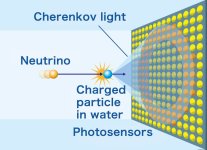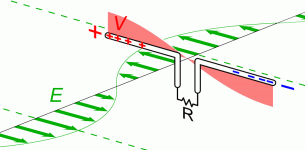I’m not sure about your detective work that radio frequencies are way down low in the frequency spectrum.
Mister Audio is correct in that radio waves are at the low frequency, long wavelength end of the electromagnetic spectrum.
The Schumann frequency electromagnetic wave, for example, has a wavelength of about 25,000 miles and has an extremely low frequency, 7.83 Hz.
And finally, electrons don’t emit electromagnetic energy, the e and b fields are produced by the electromagnetic wave. The electrons carry the charges.
They can, see Cherenkov radiation.
https://www.iaea.org/newscenter/news/what-is-cherenkov-radiation
Last edited:
I've wondered about "photons" and the (lower-than-infrared EM range) radio spectrum. For visible light, individual photons have enough energy to be detected, as in a photomultiplier tube. Radio waves are also made up of photons, but each one has orders of magnitude lower energy than an optical photon, and is way too weak to be detected. I wonder about a barely detectable signal hitting a receiving antenna, how many photons per second hit it. I'm guessing energy is inversely proportional to frequency, which means its energy is many orders of magnitude lower. Of course the optical wavelength/frequency range is about a 2 to 1 range, whereas commonly used "radio waves" go from 100 kHz to at least 10s of GHz, a frequency range at least 5 orders of magnitude.
What's the frequency/wavelength of the lowest frequency single photon that can be detected?
What's the frequency/wavelength of the lowest frequency single photon that can be detected?
Cherenkov radiation
IceCube detects light emitted by charged particles that are produced when a single neutrino crashes into a water molecule.
These charged particles travel faster than light in the ice and give off a blue light called Cherenkov radiation.
Attachments
What's the frequency/wavelength of the lowest frequency single photon that can be detected?
I believe we can detect individual photons in the Cosmic Microwave Background, which corresponds to a frequency of about 60 GHz and wavelength around 5 mm.
This is made possible by superconducting detectors as referred to by Mister Audio: https://en.wikipedia.org/wiki/Kinetic_inductance_detector
Schumann frequency electromagnetic wave
For the benefit of our casual observers: Low frequency electromagnetic waves can propagate between the surface and the ionosphere of Earth causing a resonance that was first studied by Schumann in 1952. This Schumann resonance is related to lightning activity and climatology.
"If you want to know the secrets of the Universe, think in terms of energy, frequency and vibration." - Nikola Tesla
They travel at the speed of light in that medium, which is not the speed of light in a vacuum of course.Not quite, more like 0.7c.
They have glass and reflections.
The reflections are not relevant to the speed of the photons - just the distance of travel.
How would you describe two coupled inductors in which one, let’s call it the driven inductor, is not oscillatory?
That sounds like a specialist subject of yours!
All I know is that electrons radiate EM radiation when they accelerate.
This requires a change in velocity, which can be either a change in speed or a change in direction.
If an electron simply "moves" in a wire it produces a magnetic field, but this magnetic field is constant because the electron has a constant velocity.
All I know is that electrons radiate EM radiation when they accelerate.
This requires a change in velocity, which can be either a change in speed or a change in direction.
If an electron simply "moves" in a wire it produces a magnetic field, but this magnetic field is constant because the electron has a constant velocity.
I've managed to pick up whisper mode on 10m, It's caused by reflections travelling all around the world with a delay between each bounce.Low frequency electromagnetic waves can propagate between the surface and the ionosphere of Earth
Submarines use VLF to communicate while under water. Mentioned years ago. I've always wondered about encoding. It might take a lot longer to transmit any info compared with more normal wavelengths. Rather a lot longer. Not much info about
https://en.wikipedia.org/wiki/Communication_with_submarines
plus links off that.
plus links off that.
The VLF (Very Low Frequency) link helpfully tells us that, due to its limited bandwidth, audio (voice) transmission is highly impractical in this band, and therefore only low data rate coded signals are used.
And, because of the high powers and very large antennas that are required for transmission, VLF communication is always one-way, from land to submarine.
Learning all the time! 😎
time, a millionth of an inch of whatever. Also, I’m not sure about your detective work that radio frequencies are way down low in the frequency spectrum.
-------------------------------------------------------------------------------------------------------------------------------------------------------------------------
I would consider X-rays and Gamma radiation to be way higher up the frequency spectrum than radio frequencies.
-------------------------------------------------------------------------------------------------------------------------------------------------------------------------
I would consider X-rays and Gamma radiation to be way higher up the frequency spectrum than radio frequencies.
Submarines use VLF to communicate while under water.
-------------------------------------------------------------- >
Elephants use infrasonic frequencies to communicate while on land 😉
-------------------------------------------------------------- >
Elephants use infrasonic frequencies to communicate while on land 😉
I've read about this before, here's an interesting article discussing using 72Hzfrequencies:
https://pages.hep.wisc.edu/~prepost/ELF.pdf
I've read (don't remember where other than The Internet) that they now use slightly higher frequencies - they don't penetrate as well, but modern DSP based receivers in the subs can pull the signals out of the noise better than previous receivers, thus the transmitters and transmitting antennas don't need to be as "extreme."
https://pages.hep.wisc.edu/~prepost/ELF.pdf
I've read (don't remember where other than The Internet) that they now use slightly higher frequencies - they don't penetrate as well, but modern DSP based receivers in the subs can pull the signals out of the noise better than previous receivers, thus the transmitters and transmitting antennas don't need to be as "extreme."
Besides the impracticality of large antennas, Shannon’s Theorem also places strict limits on the max amount of data that can be encoded per unit bandwidth.The VLF (Very Low Frequency) link helpfully tells us that, due to its limited bandwidth, audio (voice) transmission is highly impractical in this band, and therefore only low data rate coded signals are used.
And, because of the high powers and very large antennas that are required for transmission, VLF communication is always one-way, from land to submarine.
View attachment 1228913
Learning all the time! 😎
That’s audio and not EM communication though.Submarines use VLF to communicate while under water.
-------------------------------------------------------------- >
Elephants use infrasonic frequencies to communicate while on land 😉
- Home
- Member Areas
- The Lounge
- Does this explain what generates gravity?

